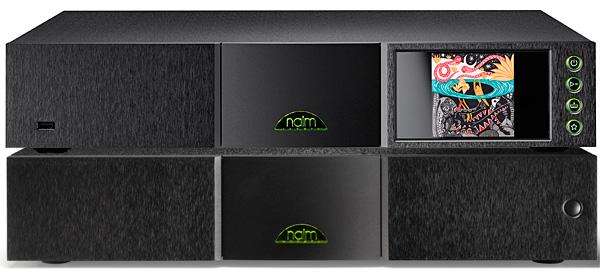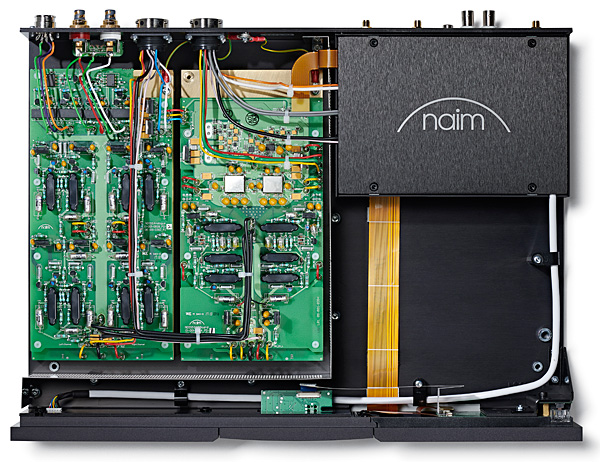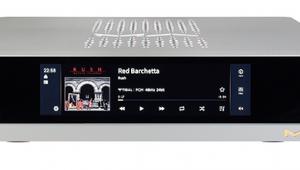Naim Audio ND 555/555PS DR Network-Attached DAC

 The new flagship player network player from Naim ups the ante – not to mention the price – from the company's previous range. Is the performance elevated, too?
The new flagship player network player from Naim ups the ante – not to mention the price – from the company's previous range. Is the performance elevated, too?
The ND 555, sitting at the top of Naim's latest three-strong network player/streamer/call-it-what-you-will range at £12,999, isn't a direct replacement for the 'old' NDS. Yes, that player is now discontinued, but note I said the ND 555 isn't a 'direct' replacement – after all, the new model is more than twice the price of its forebear...
You'll also need to invest a further £6599 in Naim's 555PS DR power supply, which connects to the player with twin Burndy cables to power the digital and analogue sections. As with the NDS, the new model has no onboard power provision. So that brings us up to just under £19,600 for the unit we have here, and if you wanted to take things to the extreme you could add a second power supply, bringing your bill to over £26,000.
Future-Proof Platform
For all that, the ND 555 simply looks like an NDX 2 [HFN Sep '18] built on a grand scale. The most obvious difference from the old NDS is the replacement of that unit's functional but slightly archaic green on black display with a full-colour screen. That display hints at some of what's inside the unit. Like all current Naim ND series and Uniti models, the ND 555 is built around the company's much-vaunted 'platform for the future' (at the time of its debut in the reinvented Uniti range this was floated as a logical upgrade for the ND series).

The new NP800 platform is a complete software/hardware package that not only boasts enhanced performance, it also adds functionality, and makes it simpler for the company to add more when required. The headline points are that the ND 555, like the NDX 2 and ND5 XS 2 [HFN Jan '19], now supports
PCM-based audio files of up to 384kHz/32-bit and DSD up to 128/5.6MHz. It's also now Roon-ready to allow it to function as an endpoint in a system using that excellent library/playback package. And thanks to the inclusion of Chromecast audio, it's now compatible with a huge range of apps playing audio or video soundtracks, at up to 192kHz/24-bit. Digital inputs are also included, on Toslink, RCA and BNC connections and able to accept up to 192kHz/24-bit, and the player also has front and back USB-A ports, which can be used for playing content from memory devices.

Indeed, such is the scope of this new player that it seems Naim is guilty of only one significant omission: a manual. There's none in the box beyond a Quick Start Guide that's simple to the point of being vestigial, and a search of the Naim site reveals only the same guide available for download.
True, anyone buying the ND 555 is likely to have it installed by an authorised Naim retailer, who presumably will be well-placed to both optimise the set-up and explain the functionality in detail, but Naim seems to have moved away from providing full manuals for its products. And if ever something deserved a comprehensive and informative manual for installation and operation, the ND 555 is it.
King Of The Cage
The radio-connected remote control, meaning no 'line of sight' is required, is a more upmarket, metal-cased, version of the one supplied with the NDX 2, and of course is black with green illumination. You'll need to study that Quick Start Guide in order to get to grips with its iconography, and that of the front-panel buttons, so better by far is to stick to 'driving' the ND 555 with the Naim app, available for both iOS and Android phones and tablets.

The app is still being continually upgraded and with a little familiarisation it's pretty intuitive in use. It also adds levels of flexibility to the operation of the player that you won't realise with the remote handset alone. For example, a terminal on the rear of the player can connect via cable to a suitable Naim amplifier, allowing the app to control its volume and muting, and also select preamp inputs if required. The ND 555 does also offer a choice of fixed or variable analogue outputs, on both Naim's customary DIN as well as a pair of RCA sockets, but the variable out is there only to satisfy the multiroom requirements of the Apple AirPlay implementation on offer here. Strictly, it's not a recommended way of connecting the player directly to a power amplifier.
The principles of the ND 555 are much the same as those of the NDS, in that the main circuitry is 'floated' on leaf springs, thus requiring four transit screws to be removed from below before the player is used, which is only a slightly tricky exercise. However, in the new machine this isolation is ramped up with the use of two hefty brass plates carrying the main circuitboards, the 'SpringBoard' construction said to isolate them from all vibration above 10Hz. In addition, the streaming section is mounted in an improved version of the Faraday Cage that was first seen in the NDS. This is not only physically isolated from the rest of the player but is claimed to be 'radio opaque' up to a considerably higher frequency.
In streaming or UPnP mode, the NP800 platform is governed by Naim's 'ClockMaster' system, which is mounted close to the DAC chips to minimise jitter. The DACs are also mounted in their own Faraday cages and, to put it mildly, are a tried-and-tested technology. Naim continues to use them, in a carefully selected form, simply because they are considered by the designers and engineers to be the best-sounding.























































